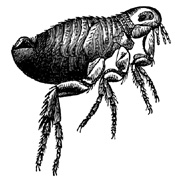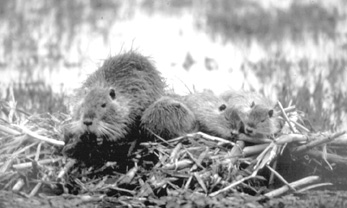
Dock of the Bay

Volume VI Number 34
August 27-September 2, 1998
Fishing Flap: New Fee Has Virginians
in Saltwater Snit
photo by Bill Lambrecht Capt. John Deering's mad as a wet cat that Virginians fishing in Maryland's Bay waters pay more.
John Deering lives in Virginia and works at the State Department. But when he received his Maryland renewal for a non-resident fishing guide license along with a new $350 surcharge, Deering's response fell short of diplomatic.
"Hey Bozo," Deering began his letter to the Department of Natural Resources and members of the Maryland General Assembly. "What is your basis for charging a Virginia resident who is also a licensed Maryland fishing guide more fees for the Maryland license?"
It remains to be seen whether Deering's crusade will bring fellow Virginians relief or whether Virginia officials will retaliate by penalizing Maryland charterboat captains.
For now, what's certain is that Virginians plying their fishing wiles for a fee in Maryland are up in arms about a new provision in Maryland law demanding $350 on top of the $100 they already pay. And we're likely to hear more on the matter.
The new provision was signed into law in May, but charterboat captains are just now reading the fine print in time for Aug. 31 renewals.
It says out-of-staters seeking the new license will be assessed the difference in the amount that their state charges our charterboat captains - or $350.
The proposal worked its way into the General Assembly from a panel made up of environmental advocates, charterboat captains and fishing groups, said Pete Jensen, deputy director of fisheries for Maryland's Department of Natural Resources.
Jensen said it was a matter of seeking "equivalency" with other states, such as Delaware, which charges $1,000 or more for some of its licenses. But the driving motivation, he said, was the belief that Maryland needs to protect its resources by making it more costly for others to partake of them.
"I think we needed to do it because its very much a part of our limited entry policies," he said. "We have limited resources and we need to limit the number of people out there. We need to keep a balance."
Jensen said the $350 figure was reached by tabulating the costs of such benefits to watermen as marine police protection and channel makers. Jensen knows that Virginians aren't happy; he's received 10 or 12 calls on the matter. But he said that he doesn't expect retaliation in part because a related effort a few years ago by Virginia affecting southern Maryland captains was thrown out by a judge.
The Maryland Saltwater Sportfishermen's Association was among members of the Limited Entry Workgroup. But after hearing from Deering, executive director Richard Novotny wrote to Jensen to say that he can't recall the surcharge being discussed. (He also said he might have overlooked the change in the draft legislation he received.)
Novotny added: "I feel that he [Deering] has raised a very good point and that it should be addressed Since we imposed this additional fee to out-of-state captains, are those states going to retaliate?"
They just might.
The Virginia Marine Resources Commission plans to take up the matter at a meeting this week and recommendations could lead either to regulatory changes or to new legislation aimed at Marylanders, said Rob O'Reilly, the commission's assistant chief of resources management.
"Commission members are very concerned about this. They've had this agreement where we've had pretty good reciprocity. Now, all of a sudden, there is this extra fee," he said.
Whatever the Virginians do, it won't be soon enough for John Deering. In addition to his Arlington residence, Deering, 51, has a home in Shady Side which, he notes, makes him a taxpayer in Maryland. He's unhappy with answers he's received from DNR and he's written a second angry letter, this time adding Gov. Parris Glendening to his list.
Deering takes out fishing parties from the State Department and government agencies, but his boat is not a big part of his income. To him, it's a matter of fairness, given the fact that Virginia captains now must pay nine times the $50 assessed Marylanders.
"I'm a man of principle; it's the principle of it that irritates me," he said.
-BL
Hospice Cup: Get Ready For the Grandest Race To Give
"On the Lay Line," by sailing painter
Willard Bond. Sales of prints of Bond's oil painting help increase the take
of the nation's 12 regattas modeled after Chesapeake Bay's Hospice Cup.
Charity is often its own reward in Chesapeake Country, where fund-raisers lubricate the giving impulse with some extraordinary forms of fun.
In August, at Calvert County's 17-year-old Cancer Crusade Gala, the fun was feasting. Throngs fed as lavishly on lobster, champagne, chocolate mousse and dozens more delicacies, helping to raise $130,000. That's the biggest take ever and keeps the traditional Rod 'n' Reel fund-raiser the American Cancer Society's most productive outdoors fundraising event in Maryland.
Come September, another star rises on the fund-raising circuit as Hospice Cup makes its 17th return to Chesapeake waters. Here the fun is divided between racing and sharing spindrift sprays with racers, the rich and the famous.
The heart of the September 19 regatta is a race of over 100 sailboats. Sailors range from wind-addicted racers to hospice volunteers and family caregivers; boats from midgets to 85-foot yachts, which compete in 11 racing and three special classes under the direction of the Shearwater Yacht Club. Between the West and Severn rivers, they follow Olympic 'L' and 'M' courses for the pleasure of speed, trophies and to up their year-end scores in the Chesapeake Bay Yacht Racing Association.
"They're the fun; they put on the show for the people watching," says Peggy McCaig, a volunteer and organizer for a dozen years. "It's crazy. In sailboat racing, you never know what's going to happen till the day occurs."
Not all the fun is reserved for racers. Another contingent gets to watch from the decks of Lady Baltimore - which in itself, so the saying goes, might be about as interesting as watching paint dry. Add sipping champagne over lunch and listening to color commentary and "it's wonderful," says McCaig. "These Shearwater Yacht Club commentators tell you what the boats are doing - and what they should be doing."
After the race, these mates, navigators, commodores and admirals settle down to lawn party. This year's lawns belong to the mansion Manresa, on the shores of the Severn River, where both food and elbow-rubbing are good.
Chairing the race over the year have been governors and, in recent years, celebrities, who spread themselves generously around on spectator boat and lawn party. Some of the celebrity honorary chairs, having made their fame elsewhere, take their leisure in Chesapeake Country. Thus Walter Cronkite chaired Hospice Cup in 1996 and conservative journalist and yachtsman William F. Buckley Jr. in 1997. Other honorary chairs define some aspect of Chesapeake Country - for example Pulitzer-Prize winning author of Beautiful Swimmers, William Warner, in 1993. This year's chair is George Collins - skipper, founder and director of Chessie Racing, Maryland's entry in this summer's Whitbread Round the World Race.
All that raises considerable funds. Hospice Cup typically brings in its $300,000 goal and, in its 17-year-history, has contributed $3 million to Maryland and Virginia hospices. Racers contribute their entry fees, and sponsors range from yeomen, who contribute up to $249, to fleet sponsors, whose gifts range upward from $15,000.
"A lot of the people involved most closely," explains McCaig, who belongs to the category she's describing, "who are had a family member taken care of by hospice. I've been involved 18 years as a volunteer and on the board and benefited so much from what I've learned and done and the friendships I've made.
"Other sponsors really believe in the hospice concept and want to make sure it's there for them when their time comes. We in hospice believe the end of life is as important, meaningful and beneficial as the beginning of life. Hospice is the ground work that helps people tie up their loose ends."
Some contributions are tagged for one or another of the six benefiting hospices, including, in Chesapeake Country, Hospice of Anne Arundel County, Calvert Hospice and Hospice of the Chesapeake. The remainder is divided among the hospices. As in Calvert County's Cancer Gala, all the work is done by volunteers.
Hospice Cup funds support patient care for patients without insurance, Medicare or Medicaid or fills in gaps - such as bereavement care to survivors - not covered. Cancer Gala supports both patient care and local, cancer-fighting research, often at Johns Hopkins University and the University of Maryland.
Still other Hospice Cup supporters join to work with friends on a worthwhile project. Racers, of course, can pick up end-of-season points to improve their standing.
So, McCaig concludes, "Hospice Cup is a good venue for hospice people, sailors and fun-loving people too."
Donate as little as $250 and share in the fun as a first mate watching the race from Lady Baltimore with commentary, continental breakfast and champagne lunch plus the post-race dinner party and silent auction at Manresa. Learn more about participating as a sailor, sponsor or spectator from Mary Radzik: 703/538-2962 www.allenwayne.com/printing/hospice.
-SOM
Flea Fights: Good News of Pests Nearly Conquered
 Fleas -
infesters of fur and feather, scourge of humankind, shakers of empires,
makers of misery for the warm-blooded across millions of years - could it
be time in this usual season of infestation to say, 'We hardly knew ye?'
Fleas -
infesters of fur and feather, scourge of humankind, shakers of empires,
makers of misery for the warm-blooded across millions of years - could it
be time in this usual season of infestation to say, 'We hardly knew ye?'
After ages of suffering under the fang, humans may have found a successful strategy to stop flea infestations at home for good. Key to that strategy is a new array of non-pesticide control products known as insect growth regulators.
"Insect growth regulators are the big breakthrough in the war against fleas," says Robert Lewis, a renowned entomologist and retired professor at Iowa State University. "Not only do they eliminate fleas, they're virtually non-toxic to warm-blooded animals."
Insect growth regulators contain synthetic compounds that mimic a juvenile hormone produced by a flea in its pupal, or cocoon, stage. When exposed to growth regulators, eggs and larvae won't develop. Because flea eggs and larvae comprise over 90 percent of a typical flea population, indoor flea infestations can be snuffed out without the use of pesticides in a matter of weeks.
Growth regulators can be sprayed on carpets, bedding and furniture where eggs and larvae develop as well as directly on pets' fur. Indoors, the chemicals remain active for up to three months, making them extremely effective for long-term household flea control, says Lewis. Three insect growth regulators are available for homeowner use: methoprene, which is also used for larval mosquito control, under the brand names Precor and Ovitrol; pyriproxyfen, sold as Nylor or Archer; and fenoxycarb, sold as Torus.
Fleas are also suffering from insect development inhibitors, which prevent eggs from hatching. Marketed through veterinarians under the name Program, lufenuron is fed to pets in pill or liquid form that slowly releases into the pet's bloodstream. When a female flea bites a treated pet, she ingests lufenuron along with the blood. Inside the flea, lufenuron is absorbed by developing eggs. As long as the female feeds on the treated pet, she will produce eggs that won't hatch. No more eggs, no more fleas, no more problem.
Since their introduction five years ago, insect growth regulators have been so successful at suppressing fleas that professional pest control operators are a little worried. Except in New England, pest control companies' income from flea accounts has sagged across the nation, according to a report last year by University of California entomologist Nancy Hinkle.
"I wouldn't say it's dead, but the market for professional flea control has decreased significantly in the past few years," Hinkle said in a recent telephone interview.
According to her estimates, pest control companies currently reap about $348 million of the total $4.31 billion that pet owners spend annually on flea control. That's only about eight percent of the market. That share is even smaller when the $1 billion or so spent each year at the vet on flea-related medical problems like dermatitis and tapeworms is added in.
Why the slump? Part of the decline, says Hinkle, is due in parts of the country to drier weather, which dampens outbreaks of fleas. However, Hinkle observes, more pet owners are turning to their vets for the new breed of flea control products, particularly those containing insect growth regulators.
Adding to the exterminator's woes are powerful "on-the-pet" pesticides available only through veterinarians, such as imidacloprid (Advantage), fipronil (Frontline), and fenthion (Pro-Spot) that effectively kill adult fleas for a month or more with each application.
Lest fleas should think the outdoors are safe for raising families, homeowners have a number of effective yard and garden flea products at their disposal, including new biological insecticides that contain flea-busting parasitic worms. Sold at retail home and garden centers under the name Millenia, BioFlea 100, BioFlea Halt and Nature Guard for Fleas, encapsulated parasitic worms are dissolved in water then sprayed over the lawn, especially on "hot spots" where immature fleas thrive: under bushes, dog houses, wherever pets rest.
Once in the soil, the worms seek out and attack flea larvae and pupae, infecting them with bacteria lethal to fleas. With no more fleas, the worms die.
Are fleas history then?
"No, I don't think so," says Lewis, the world-class flea expert, adding that only a handful of flea species pose a problem to people. "There are still lots more out there."
Hinkle isn't writing off fleas, either, especially not cat fleas, the most common flea in North America.
"The cat flea has eclectic tastes," says Hinkle. "It'll feed on a variety of hosts: raccoons, possums, squirrels, groundhogs, just about any mammal. So fleas aren't going away. We might rid our lives of them for a while, but it's just a temporary situation. As long as we let our pets outside, we'll continue to have problems with fleas."
That seems to be the case in these parts, judging, at least, from the experience of local exterminator David Phillipe.
"Business has been picking up since the early part of July, on account of the heat and humidity," reports Phillipe, owner and operator of Pest Control, Inc. in Davidsonville and 20-year veteran of flea wars. "Lately, I'm going out on two to three jobs each day," says Phillipe, including both home and yard treatments. This year, he says fleas are hopping highest in Calvert County, where the sandy soil makes an ideal incubator for flea eggs and larvae.
In a typical year, Phillipe sees two explosions of fleas: once in early spring, when the weather turns warm, then again in early fall, after the first cold snap.
"That's when people first cut on their heat. As soon as they do, the eggs start hatching."
So we can't say 'so long' to fleas just yet. Just as well, too. It's hard to imagine life without them.
-Don Kehne
Invasion: Nibbling Nutria Menace Marshland
You're sipping an afternoon cocktail poolside. The
sun's rays feel deliciously warm. You glance around your yard, only to notice
something else is napping in the sun. It's some sort of rodent. It looks
to be an extremely large muskrat with huge teeth. You jump up in fear of
this odd creature - when it awakens and hurries away, too. Phew!
Bayside residents may recognize this scenario.
The culprit is the nutria, Myocastor coypus, and he's chomping his way along the Eastern and Western shores, eating vegetation and annoying homeowners.
"They seem to be taking over," Fairhaven resident Barbara Miller said of the four currently loafing on her land. "Last year we spotted one nutria, and by next year there will probably be 10."
Nutria are muskrat or beaver-like with long, thin rat tails and webbed feet. Their large chisel teeth make chewing on veggies easy. They prefer to lounge around streams, ponds, swamps and marshes.
Miller's pesky pals camped out under her patio and sunbathed on logs at nearby wetlands.
These South American natives like it warm, though they've adapted nicely - too nicely nowadays - to Maryland, after they were introduced to the Eastern shore in 1943 to boost the fur industry. Good idea turned sour.
 Fur coats
are no longer in demand, but the nutria family is multiplying. Nutria breed
all year long and average nine offspring at a time.
Fur coats
are no longer in demand, but the nutria family is multiplying. Nutria breed
all year long and average nine offspring at a time.
Typically, cold weather keeps the population in check. Nutria lack the weather-adaptive mechanisms of their native cousins, muskrats.
"If we'd had any hard winters they would not have survived," says Maryland Del. Virginia Clagett, who got involved when constituents called her for help. But, "for the last 10 years we've not had a major freeze."
The nutria problem goes deeper than unwelcome visits to area residents. The furry foreigners have been implicated in the loss of an alarming acreage of marshland in the area. Dorchester County has suffered most, according to Clagett, who calls nutria "a major problem on the Eastern Shore and more recently a problem on the Western Shore."
Weighing a hefty 18 pounds or more, nutria love to munch. But unlike muskrats, nutria dig deep down into the marshland straight to the roots of the vegetation. This allows tidal water to enter, eroding the marsh from beneath until it gives way to open water.
Though these nibblers are not fully to blame for marsh loss, they've certainly sped up the natural process.
The amazing loss of marsh combined with the extreme abundance of nutria prompted a 10-year nutria eradication program. Eradication is scheduled to begin in 2000, after a joint study by the Maryland Department of Natural Resources, the Blackwater Wildlife Refuge and the Patuxent Wildlife Research Center to determine the effect of nutria on marsh loss.
At Blackwater Wildlife Refuge - a popular spot for biking and nature watching - "most of the sensitive part of the marsh is gone," according to Mike Haramis, head of the study and Wildlife Biologist at Patuxent.
"The marsh will not survive," says Haramis, "unless the nutria population is managed."
Researchers aren't sure what to do. In England, where nutria are also a problem, researcher L.M. Gosling found that male nutria move around more than females. So he successfully trapped males to shut off reproduction.
Several trapping techniques are used. The Animal Nuisance Information Hotline, a public information service, gives tips for trapping nutria and other annoying animals. They'll also refer you to licensed trappers who will corner and remove your problem critters, to be euthanized. Some trappers use the quick-kill neck-snapping method.
To save our delicate shores, a broader removal policy is in the works. Until then, advises Haramis, nutria will be popping up all over.
Meanwhile, if you happen to see this oversized rodent with scissors-like teeth and a flat tail roaming your yard, don't fear: he only wants your veggies. But if your yard is marshland, maybe you'd better serve him lettuce.
Reach the Animal Nuisance Information Hotline at 800/442-0708.
-Darcey Dodd
Ohio Lt. Gov. Nancy Hollister, a Republican, may need to pay Maryland Gov. Parris Glendening royalties. Hollister named Ohio's new growth management policy introduced last week the "Smart Growth" program - Glendening's name for the new Maryland law that he engineered last year ...
In San Francisco, complaints about reckless operators have prompted city officials to seriously consider banning the use of personal watercraft within 1,200 feet of the city's shoreline along the Pacific Ocean, the San Francisco Examiner reported this week. Similar moves are afoot in other bay-area jurisdictions ...
In Washington, a lawsuit filed in U.S. District Court says that hundreds of porpoises die each year in East Coast waters in the gill nets of fishermen. The suit, filed by the Center for Marine Conservation, aims to force netters to do more than attach "pingers" on nets to warn away porpoises ...
Michigan is a venue for a new industry: eco-friendly
burial. If you don't mind cremation, your remains can be deposited in one-square-foot
plots being offered at the Brundage Wilderness in Michigan's
Pere Marquette State Forest ...
Swedish researcher Gunnar Sundquist has found a new way to make paper - from moose droppings, the Toronto Globe and Mail reports. It takes about eight pounds to make 400 sheets ...
Our Creature Feature comes to us from China, where people in the city of Zhengzhou are poles apart in the debate over what to do over a related pollution problem: egret droppings.
Many people have become so weary of the egrets' messes that they have started a campaign to get rid of the birds, according to a report in China Today. But a rival group says the egrets are so special that they should be adopted as the city's emblem.
Said a woman from the latter camp: "Parents never abandon their children simply because they get dirty."
| Back to Archives |
Volume VI Number 34
August 27-September 2, 1998
New Bay Times
| Homepage |